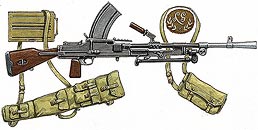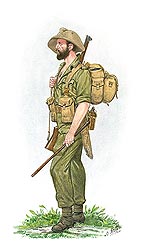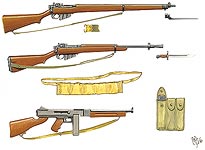The Second World War 1939-1945
The Queen's Royal (West Surrey) Regiment

 |
| Sergeant of the 1st Queen's, Burma 1944. |
The Regular Battalions
The 1st Battalion Queen’s Royal (West Surrey) Regiment continued to serve in India at the start of the Second World War
and fought for a year against tribesmen on the North-West Frontier.
The Battalion then transferred to Burma and saw a great deal of
hard fighting against the Japanese in the Arakan, at Kohima and
in the Irrawaddy operations. After the Japanese surrender, the
1st Battalion spent a short period in Malaya, before returning
home.
The 2nd Battalion moved to Egypt from Palestine in 1940 and fought in the Battle of Sidi Barrani and at Tobruk. It then moved back to Egypt and then Syria. This was followed by a peaceful year in Ceylon, prior to a move to Burma, where it served as part of the Deep Penetration Forces (Chindits) against the Japanese. After the War, the 2nd Battalion moved back to India, where it remained until 1947.
 |
| A Chindit, 2nd Battalion The Queen's Royal Regiment. |
The Territorial Battalions
The Territorial Force was disbanded after the First World War, but reconstituted as the Territorial Army (TA) in 1921. In 1938, the TA battalions were ordered to double their strength. The Queen’s battalions formed into two brigades; 131 (Queen’s) Brigade consisted of 1/5th, 1/6th and 1/7th Queen’s and 169 (Queen’s) Brigade was made up of 2/5th, 2/6th and 2/7th Queen’s. All six Territorial battalions fought in France in 1940. Two years later, both brigades were ordered overseas and fought in the Eighth Army in the Western Desert. 131 Brigade became the Lorried Infantry brigade of 7 Armoured Division (the “Desert Rats”) after the Battle of El Alamein. 169 Brigade joined 56 London Division (the “Black Cats”) and took part in the capture of Tunis in May 1943.
 |
| Rifle Lee Enfield Number 4, Mark 1. Lee Enfield Number 5, Mark 1 (the jungle carbine). Cotton bandolier for fifty rounds. US Thompson sub-machine gun, M1 with magazine pouch. |
Both brigades fought in the allied landing at Salerno, Italy in September 1943; one relieving the other. They then took part in some of the bloodiest fighting in Italy. When the Battle Honours were awarded for the Second World War, seventeen were awarded to the Queen's. "Salerno", "Monte Camino", "Anzio", "Gemmano Ridge" emblazoned on the Queen's Colour, whilst "Monte Stella", "Scafati Bridge", "Volturno Crossing", "Garigliano Crossing", "Damiano", "Gothic Line", "Senio Pocket", "Senio Floodbank", "Cusa Fabri Ridge", "Menate", "Filo", "Argento Gap" and "Italy 1943-45" were awarded as Battle Honours.
131 Brigade then returned to England for the invasion of north-west Europe and eventually helped to push the Germans back across the River Maas. 1/5th Queen’s ended the War in Hamburg, later moving to Berlin, where it took part in the Victory Parade in front of Winston Churchill.
At the end of the Second World War, the TA again changed shape, as battalions were disbanded. 5th Queen’s was reformed in 1947, with its headquarters at Sandfield Terrace, Guildford. The TA Infantry remained in various forms at Sandfield Terrace until their most recent reorganisation in 1999. 6th Queen’s was reformed in the same year at Jamaica Road, Bermondsey.
